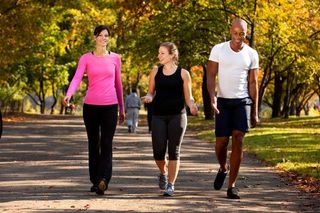Walking for Exercise on the Rise in US, Especially in Southerners and Men

People in the U.S. are walking more now than in the past, particularly those who live in the South, according to a new report from the Centers for Disease Control and Prevention (CDC).
Overall, 62 percent of U.S. adults said they walked for 10 minutes or more at least once during the previous week in 2010. That's up from 56 percent who said the same in 2005, a 6 percent increase over the five-year period.
The South saw the biggest increase in the percentage of people who reported walking, increasing 8 percentage points from 49 percent in 2005 to 57 percent in 2010. The rate among men in the South increased more than that of women, with men seeing a 9.6 percent jump over the five years, while the rate among women rose 5.7 percent.
The West had the largest percentage of walkers, with 68 percent of people reporting walking for 10 minutes a week in 2010. In the Northeast and Midwest, the percentages were 66 percent and 61 percent, respectively.
The age group that saw the biggest increase over the five-year period was 25- to 34-year-olds. The percentage of all people in this group who reported walking was 65.2 percent in 2010, and men again showed a larger increase (11.4 percent) than women (7.2 percent) from 2005 levels.
Physical activity provides health benefits, including a lower risk for heart disease, stroke, type 2 diabetes, depression and some cancers, the CDC says. However, only about half of U.S. adults (48 percent) get enough physical activity to improve their health. It is recommended that adults get at least 2.5 hours of moderate-to-vigorous physical activity a week to reap health benefits, the CDC says. (Moderate physical activity includes walking.)
While the increases in walking seen in this report are encouraging, "There is still room for improvement," said Joan M. Dorn, of the CDC’s Division of Nutrition, Physical Activity and Obesity. "People need more safe and convenient places to walk," Dorn said.
Sign up for the Live Science daily newsletter now
Get the world’s most fascinating discoveries delivered straight to your inbox.
Ways to provide better walking spaces include increased access to walking trails, creating walking paths around a worksite and establishing agreements to let community residents use school tracks and gyms after school hours, the CDC says.
The report appears today (Aug. 7) in the CDC's Morbidity and Mortality Weekly Report.
Pass it on: Close to two-thirds of Americans get exercise from walking, but there is room for improvement.
This story was provided by MyHealthNewsDaily, a sister site to LiveScience. Follow MyHealthNewsDaily on Twitter @MyHealth_MHND. We're also on Facebook & Google+.
Most Popular


